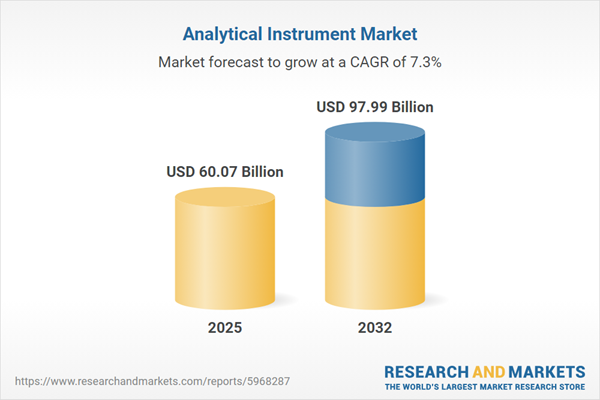Speak directly to the analyst to clarify any post sales queries you may have.
The analytical instrument market is a critical driver of quality, innovation, and efficiency for global industries, rapidly adapting to shifting regulatory standards, technological advances, and evolving customer needs. Senior executives must navigate this complex landscape to capture opportunities and build lasting competitive advantage.
Market Snapshot: Analytical Instrument Market Growth Trajectory
The analytical instrument market grew from USD 55.96 billion in 2024 to USD 60.07 billion in 2025. With an expected CAGR of 7.25%, it is forecasted to reach USD 97.99 billion by 2032.
This robust outlook reflects increasing demand for precise measurement solutions across sectors, driven by stricter environmental regulations, pharmaceutical research acceleration, and advancements in biotechnological processes. Automation, digital integration, and sustainable product development are among the foremost trends propelling this market forward.Scope & Segmentation: Industry Breadth and Opportunities
- Product Types: Chromatography including gas, ion, liquid (high performance and ultra high performance), and size exclusion; Mass spectrometry; Spectroscopy; Electrochemical analyzers.
- Applications: Academic research, biotechnology, environmental testing, food and beverage analysis, pharmaceutical processes such as drug discovery, quality control, and research development.
- End Users: Academic and government institutions, chemical and petrochemical companies, environmental testing organizations, food and beverage producers, and the broader pharmaceutical and biotechnology sector encompassing biotech firms, contract research organizations, and pharmaceutical manufacturers.
- Sales Channels: Distributors, third-party distributors, value-added resellers, OEM direct, and online procurement channels.
- Ownership Models: Finance and operating leases, and direct purchase models tailored for diverse financial strategies.
- Key Regions: Americas (United States, Canada, Mexico, Brazil, Argentina, Chile, Colombia, Peru), Europe, Middle East & Africa (including United Kingdom, Germany, France, Russia, Italy, Spain, Netherlands, Sweden, Poland, Switzerland, United Arab Emirates, Saudi Arabia, Qatar, Turkey, Israel, South Africa, Nigeria, Egypt, Kenya), and Asia-Pacific (China, India, Japan, Australia, South Korea, Indonesia, Thailand, Malaysia, Singapore, Taiwan).
- Leading Companies: Thermo Fisher Scientific Inc., Danaher Corporation, Agilent Technologies Inc., Shimadzu Corporation, PerkinElmer, Inc., Waters Corporation, Bruker Corporation, Mettler-Toledo International Inc., Hitachi High-Tech Corporation, and JASCO Corporation.
Key Takeaways for Senior Decision-Makers
- Automation and digitalization enhance data workflows, streamline sample preparation, and support real-time monitoring, aligning with pressing market demands for speed and accuracy.
- Cloud-based analytics and remote monitoring are becoming essential, introducing recurring service opportunities and facilitating proactive maintenance strategies.
- Integration of artificial intelligence enables predictive analytics within instruments, improving both operational uptime and data-driven decision-making.
- Sustainability is rising in priority, with manufacturers substituting hazardous reagents, increasing energy efficiency, and pursuing greener chemistries in design and production.
- Regional disparities in regulation, investment incentives, and market maturity demand localized approaches to product strategies and channel development.
- Strategic partnerships, cross-industry alliances, and M&A activity are shaping competitive positioning, with firms broadening portfolios and leveraging cross-vertical expertise.
Tariff Impact: Adjusting to U.S. Trade Measures and Supply Chain Realignment
Industry participants in the United States and globally are recalibrating procurement and manufacturing in response to 2025 tariffs on critical components and finished goods. These changes are increasing procurement complexity and costs, pushing manufacturers to adopt dual-sourcing and invest in localized supply hubs. OEMs and end users are leveraging extended maintenance contracts, lease-based acquisition, and long-term supplier agreements to manage margin pressure and cost variability. These market shifts will likely accelerate vertical integration and foster new alliances across the value chain.
Methodology & Data Sources
This report integrates primary interviews with senior executives and technical experts, supplemented by secondary research from peer-reviewed publications, conference proceedings, patent data, financial disclosures, and regulatory filings. Rigorous validation, structured segmentation, and transparent weighting methodologies ensure accurate, actionable insights on market dynamics and strategic trends.
Why This Report Matters: Actionable Insights for Industry Leadership
- Equips leaders to navigate regulatory, technological, and commercial shifts, supporting proactive, fact-based decision-making.
- Enables organizations to align investments with growth areas in automation, sustainability, and digitalization for lasting market relevance.
- Provides a clear roadmap for strengthening supply chain resilience and capitalizing on emerging partnership models.
Conclusion: Strategic Outlook for Analytical Instrument Market Stakeholders
The analytical instrument market is advancing through innovation, regulation, and global industry transformation. Executives prepared to embrace digitalization, sustainability, and regional strategy customization will be well-positioned to achieve sustained growth and operational resilience in this evolving sector.
Additional Product Information:
- Purchase of this report includes 1 year online access with quarterly updates.
- This report can be updated on request. Please contact our Customer Experience team using the Ask a Question widget on our website.
Table of Contents
3. Executive Summary
4. Market Overview
7. Cumulative Impact of Artificial Intelligence 2025
Companies Mentioned
The companies profiled in this Analytical Instrument market report include:- Thermo Fisher Scientific Inc.
- Danaher Corporation
- Agilent Technologies Inc.
- Shimadzu Corporation
- PerkinElmer, Inc.
- Waters Corporation
- Bruker Corporation
- Mettler-Toledo International Inc.
- Hitachi High-Tech Corporation
- JASCO Corporation
Table Information
| Report Attribute | Details |
|---|---|
| No. of Pages | 198 |
| Published | October 2025 |
| Forecast Period | 2025 - 2032 |
| Estimated Market Value ( USD | $ 60.07 Billion |
| Forecasted Market Value ( USD | $ 97.99 Billion |
| Compound Annual Growth Rate | 7.2% |
| Regions Covered | Global |
| No. of Companies Mentioned | 11 |









